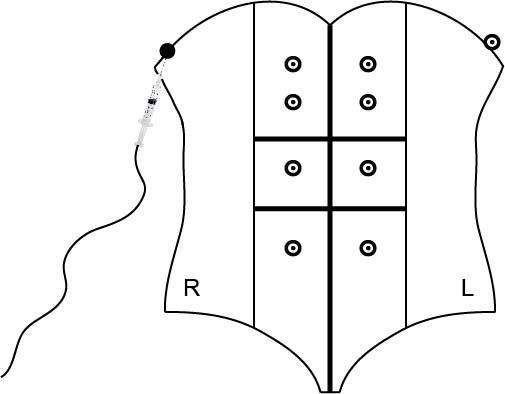Session Information
Date: Wednesday, June 7, 2017
Session Title: Myoclonus
Session Time: 1:15pm-2:45pm
Location: Exhibit Hall C
Objective: To report a rare case of diaphragmatic myoclonus, which would be the first case successfully treated by injecting Botulinum toxin A (BTX) into the diaphragm under needle electromyography guidance (EMG) in the literature.
Background: Diaphragmatic myoclonus, is a typical unusual focal dyskinesias which is characterized by repetitive involuntary synchronous contractions of the diaphragm and other respiratory muscles. (Ramirez JD et al., 2015) Its various clinical manifestations and ambiguous aetiology always lead to late diagnosis and ineffective treatments. Currently, there are still no recommendation for treating diaphragmatic myoclonus.BTX has paralysis effect and It has been injected into many muscles. However, injection of BTX into the diaphragm has never published before. This report documents the first time to apply BTX into the diaphragm under EMG guidance for the treatment of diaphragmatic myoclonus.
Methods: A 51-year-old man presented with a 5-year history of involuntary abdominal movements, which influenced his daily life and mood state. These movements, showing arrhythmia and jerky twitches and spasms of abdominal wall and thorax, associated with sagittal oscillations of upper body and sounds from larynx. All past treatments with scopolamine, Baclofen, Valproate, Clonazepam, traditional Chinese medicine or acupuncture, combined with cessation of possible medicine that might cause his syndromes had no effect. Results of fluoroscopy examination and synchronized EMG signals with spontaneous abdominal movements confirmed revealed the diagnosis of diaphragmatic myoclonus, as well as involvement of the diaphragms and the rectus abdominis. Considering hyperactivity in those muscles, the patient was an appropriate candidate for BTX injection.
Results: Following the 275 units BTX (Botox®, Allergen Pharmaceuticals Ltd, Westport, Ireland) were injected into bilateral hemidiaphragms and the rectus abdominis under EMG guidance, including 50 units in the right hemidiaphragm, 25 units in the left hemidiaphragm, and 100 units BTX in each RA (Figure 1), the patient had a significant relief in the intensity and frequency of his abdominal movements, without dyspnea, weakness of truncal flexion or other unexpected effects. This improvement continued at least 4 months.
Conclusions: With secure EMG monitoring, local BTX injections into the diaphragm and the rectus abdominis can be an alternative treatment in the cases of diaphragmatic myoclonus.
References: Ramirez JD, Gonzales M, Hoyos JA, Grisales L. Diaphragmatic flutter: A case report and literature review. Neurologia 2015;30:249-251
To cite this abstract in AMA style:
Y. He, B. Li, Y. Pan, X. Zhang, L. Jin. Diaphragmatic myoclonus successfully treated with Botulinum toxin A [abstract]. Mov Disord. 2017; 32 (suppl 2). https://www.mdsabstracts.org/abstract/diaphragmatic-myoclonus-successfully-treated-with-botulinum-toxin-a/. Accessed April 3, 2025.« Back to 2017 International Congress
MDS Abstracts - https://www.mdsabstracts.org/abstract/diaphragmatic-myoclonus-successfully-treated-with-botulinum-toxin-a/

